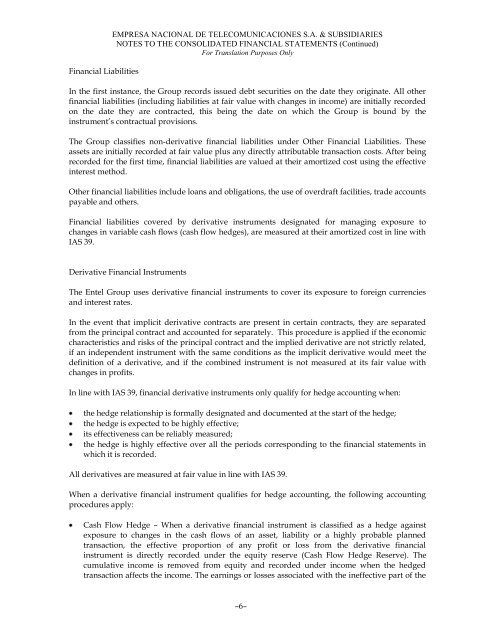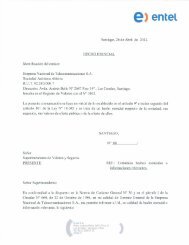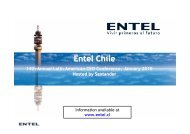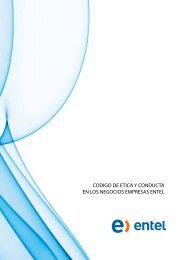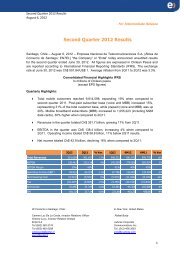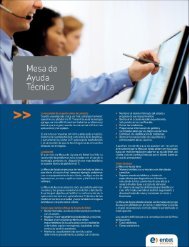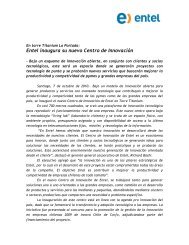Financial Statements - Entel
Financial Statements - Entel
Financial Statements - Entel
- No tags were found...
Create successful ePaper yourself
Turn your PDF publications into a flip-book with our unique Google optimized e-Paper software.
<strong>Financial</strong> LiabilitiesEMPRESA NACIONAL DE TELECOMUNICACIONES S.A. & SUBSIDIARIESNOTES TO THE CONSOLIDATED FINANCIAL STATEMENTS (Continued)For Translation Purposes OnlyIn the first instance, the Group records issued debt securities on the date they originate. All otherfinancial liabilities (including liabilities at fair value with changes in income) are initially recordedon the date they are contracted, this being the date on which the Group is bound by theinstrument’s contractual provisions.The Group classifies non-derivative financial liabilities under Other <strong>Financial</strong> Liabilities. Theseassets are initially recorded at fair value plus any directly attributable transaction costs. After beingrecorded for the first time, financial liabilities are valued at their amortized cost using the effectiveinterest method.Other financial liabilities include loans and obligations, the use of overdraft facilities, trade accountspayable and others.<strong>Financial</strong> liabilities covered by derivative instruments designated for managing exposure tochanges in variable cash flows (cash flow hedges), are measured at their amortized cost in line withIAS 39.Derivative <strong>Financial</strong> InstrumentsThe <strong>Entel</strong> Group uses derivative financial instruments to cover its exposure to foreign currenciesand interest rates.In the event that implicit derivative contracts are present in certain contracts, they are separatedfrom the principal contract and accounted for separately. This procedure is applied if the economiccharacteristics and risks of the principal contract and the implied derivative are not strictly related,if an independent instrument with the same conditions as the implicit derivative would meet thedefinition of a derivative, and if the combined instrument is not measured at its fair value withchanges in profits.In line with IAS 39, financial derivative instruments only qualify for hedge accounting when:the hedge relationship is formally designated and documented at the start of the hedge;the hedge is expected to be highly effective;its effectiveness can be reliably measured;the hedge is highly effective over all the periods corresponding to the financial statements inwhich it is recorded.All derivatives are measured at fair value in line with IAS 39.When a derivative financial instrument qualifies for hedge accounting, the following accountingprocedures apply:Cash Flow Hedge – When a derivative financial instrument is classified as a hedge againstexposure to changes in the cash flows of an asset, liability or a highly probable plannedtransaction, the effective proportion of any profit or loss from the derivative financialinstrument is directly recorded under the equity reserve (Cash Flow Hedge Reserve). Thecumulative income is removed from equity and recorded under income when the hedgedtransaction affects the income. The earnings or losses associated with the ineffective part of the–6–


